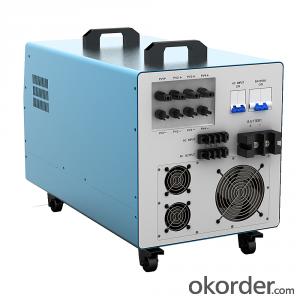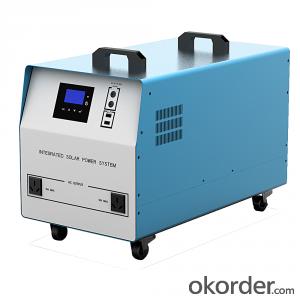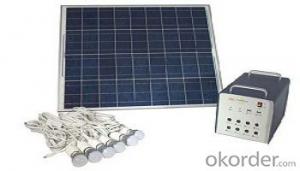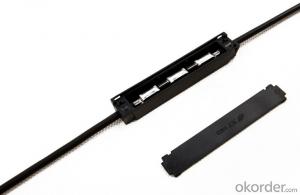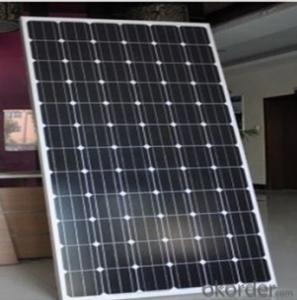5000w Portable Solar Generator Solar Power Home System kit
- Loading Port:
- China main port
- Payment Terms:
- TT OR LC
- Min Order Qty:
- 1 pc
- Supply Capability:
- 500 pc/month
OKorder Service Pledge
OKorder Financial Service
You Might Also Like
Item specifice
1. Features :
Professional design to promote system reliability
*Using international well-know brand semiconductor device such as IR.TI.ST.ON.NXP and so on.
*Using industrial MCU total digital technology, without any adjustable resistance, strong anti-interference ability, no aging and drift..
*Super-high charging and DC to AC inverter efficiency, Significantly reduce temperature rise of products .
High MPPT Tracking efficiency
*MPPT Tracking efficiency up to 99.9%,System power generation efficiency up to 98% to improves system efficiency and reduces system costs.
High Transfer efficiency
*Charging efficiency up to 98.4%
*DC to AC inverter efficiency up to 90%
Minimal stand-by power consumption
*The current consumption ≤ 40mA(24V)
Intelligent battery management
*three phase time charge battery, which contains MPPT charge, constant voltage charge and float charge, which helps to extend the life of battery.
*Significantly extends the battery life up to 50% base on intelligent temperature compensation charge and discharge management
*External battery can be added to expand battery capacity
*Intelligent battery energy management to ensures the battery operates in shallow charge and discharge states, significantly extending battery life.
Flexible setting of three output modes
*City power priority mode
*Battery priority mode
*EPS Mode
Excellent load adaptation
*Support resistive load, inductive load, capacity load, half wave load, etc
*Strong overload capacity
*Peak current ratio up to 300%
*Pure sine wave output
*output voltage level can be selected
*Sudden discharge, output waveform distortion rate low than 5%
Perfect protect function
*Battery reverse connection protection
*The solar panel reverse connection protection.
*To prevent the battery discharge to the solar panel at night.
*Battery low voltage disconnect and reconnect protection.
*Output short circuit protection
*Output overload protection
*Transformer isolation, safe and stable
2. Technical Parameter
3. Image
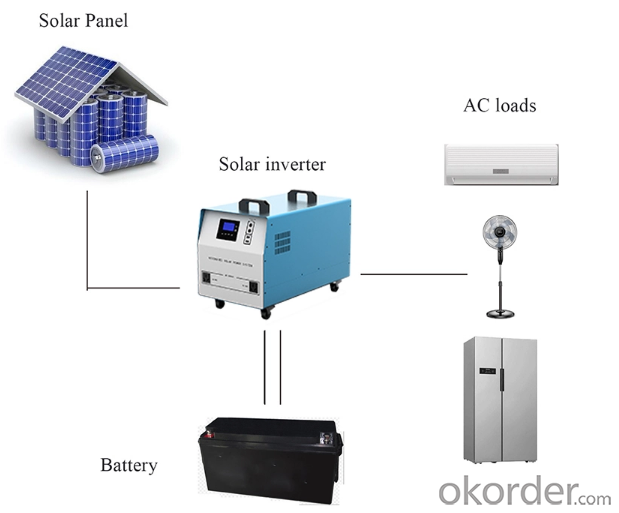
4.FAQ
Q:DO YOU HAVE ANY CERTIFICATION FOR YOUR PRODUCTS?
A:We have ISO9001:2015,CE、RoHS certifications for all of our products.
Q:DO YOU HAVE MOQ FOR PLACE ORDER?
A:Low MOQ,1pe for sample checking is available
- Q:What is the role of tracking systems in solar energy systems?
- The role of tracking systems in solar energy systems is to optimize the collection of sunlight by continuously adjusting the position of solar panels to maximize their exposure to the sun. Tracking systems help solar panels follow the sun's movement throughout the day, enabling them to capture the maximum amount of solar energy and generate more electricity. This enhances the overall efficiency and output of the solar energy system.
- Q:Can solar energy systems be used for space heating?
- Yes, solar energy systems can be used for space heating. Solar thermal systems can capture and convert sunlight into heat energy, which can then be used to heat spaces in buildings. These systems typically involve solar collectors that absorb solar radiation and transfer the heat to a fluid or air, which is then circulated through the building to provide heating. Solar energy can be a cost-effective and sustainable solution for space heating, particularly in areas with abundant sunshine.
- Q:Do solar energy systems require a backup battery system?
- No, solar energy systems do not necessarily require a backup battery system. However, adding a battery storage system can provide benefits such as storing excess energy generated during the day for use at night or during power outages.
- Q:What is the role of trackers in a solar energy system?
- Trackers play a crucial role in a solar energy system by optimizing the efficiency and output of solar panels. These devices are designed to track the movement of the sun throughout the day and adjust the position of the solar panels accordingly. By continuously orienting the panels towards the sun, trackers ensure that they receive maximum sunlight, resulting in increased energy production. The primary function of trackers is to maximize the solar energy captured by solar panels by maintaining their optimal angle relative to the sun. This is achieved through the use of sensors, motors, and control systems that enable the tracker to follow the sun's path from east to west. By continuously adjusting the panel's position, trackers can ensure that the sunlight hits the panels at a perpendicular angle, optimizing the amount of solar radiation absorbed. Trackers are particularly beneficial in locations with high variations in sunlight intensity throughout the day or across different seasons. By actively tracking the sun's movement, trackers can compensate for these variations and maintain a consistent level of solar energy production. This is especially important in regions with pronounced seasonal changes, as it allows solar panels to capture sunlight at the most effective angle year-round, maximizing their overall energy output. Furthermore, trackers can help improve the overall economics of a solar energy system. By increasing the efficiency of solar panels, trackers can generate more electricity from the same surface area. This means that fewer panels are required to produce a given amount of energy, reducing the overall cost of the system. Additionally, trackers can increase the return on investment by maximizing the energy output and reducing the payback period of the solar installation. In conclusion, the role of trackers in a solar energy system is to optimize the performance and efficiency of solar panels by continuously adjusting their position to face the sun. By maximizing the amount of sunlight captured, trackers enhance energy production, improve the economics of the system, and ensure a consistent level of solar energy generation throughout the day and across different seasons.
- Q:Can solar energy systems be used in powering art galleries or museums?
- Art galleries and museums can definitely utilize solar energy systems to power their establishments. In fact, there are numerous benefits associated with the use of solar power in these venues. Firstly, due to their large spaces and extensive lighting systems, art galleries and museums consume a significant amount of energy. By implementing solar energy systems, these establishments can generate a substantial amount of electricity, reducing their reliance on traditional energy sources and cutting down on operating expenses. Furthermore, incorporating solar energy aligns with the environmental values often associated with art and culture. By utilizing clean and renewable energy, art galleries and museums can greatly reduce their carbon footprint and contribute to global efforts in fighting climate change. Additionally, solar energy systems provide a reliable source of power, particularly during peak hours when galleries and museums experience a high influx of visitors. Moreover, the installation of solar panels on the rooftops of these establishments can serve as a visual representation of their commitment to sustainability, inspiring visitors to adopt similar practices in their own lives. However, it is important to consider that the feasibility of solar energy systems in art galleries or museums may vary depending on factors such as available roof space, geographical location, and specific energy requirements. Conducting a comprehensive assessment and feasibility study is vital to determine the optimal size and configuration of the solar energy system for each individual establishment. Overall, solar energy systems offer a clean, renewable, and cost-effective solution for powering art galleries and museums. Implementing these systems not only aligns their operations with sustainable practices but also reduces their environmental impact.
- Q:Can solar energy systems be used in powering concert halls or auditoriums?
- Certainly, concert halls and auditoriums can make use of solar energy systems to generate power. The popularity of utilizing solar energy in large venues like these has been increasing due to its various advantages. The installation of solar panels on the roof or surrounding areas of the venue allows for the capture of sunlight and its conversion into electricity. This renewable energy source can then be used to power all the electrical equipment and lighting systems within the concert hall or auditorium. One of the main benefits of incorporating solar energy systems in these venues is the potential for cost savings. Concert halls and auditoriums typically consume substantial amounts of electricity, especially during events and performances. By harnessing solar power, these venues can significantly reduce their dependence on the traditional power grid and consequently lower their energy bills. Furthermore, solar energy systems require minimal maintenance once they are installed, which further contributes to their long-term cost-effectiveness. Furthermore, the integration of solar energy into concert halls and auditoriums aligns with the global emphasis on sustainability and the reduction of carbon footprints. By utilizing renewable energy sources such as solar power, these venues can considerably decrease their greenhouse gas emissions and promote a more environmentally friendly approach to energy consumption. This not only benefits the venue itself but also contributes to the overall sustainability goals of the local community and society as a whole. However, it is important to take into account that the size and power requirements of concert halls and auditoriums may necessitate a significant investment in solar panels and related equipment. Factors such as the venue's energy demand, available installation space, and the local climate all need to be assessed during the planning stage. Ensuring that the solar energy system is appropriately sized to meet the energy needs of the venue and designed to withstand the specific weather conditions of the location is crucial. In conclusion, it is indeed possible to use solar energy systems to power concert halls or auditoriums. The advantages of employing solar power in these venues encompass cost savings, environmental sustainability, and a reduction in reliance on the traditional power grid. With careful planning and installation, solar energy can provide a reliable and efficient source of electricity to meet the energy demands of such large-scale venues.
- Q:Can solar energy systems be used in areas with limited access to sanitation facilities?
- Yes, solar energy systems can be used in areas with limited access to sanitation facilities. Solar energy systems can provide electricity to power sanitation facilities such as water pumps, filtration systems, and waste treatment processes, helping to improve sanitation conditions in these areas. Additionally, solar-powered systems can also be used to generate heat for water heating, further supporting sanitation practices.
- Q:Can solar energy systems be used for powering sports stadiums?
- Yes, solar energy systems can definitely be used for powering sports stadiums. With their large open spaces and high electricity needs, sports stadiums are ideal candidates for solar installations. Solar panels can be installed on the stadium roof or in nearby open areas to capture sunlight and convert it into electricity. This renewable energy source can help stadiums reduce their reliance on traditional power grids, lower their carbon footprint, and potentially even generate excess energy that can be fed back into the grid.
- Q:Can solar energy systems be installed in areas with extreme weather conditions?
- Yes, solar energy systems can be installed in areas with extreme weather conditions. However, the performance and durability of the system may vary depending on the specific weather conditions. Proper design, installation, and maintenance can help ensure that solar systems can withstand extreme weather events such as hurricanes, snowstorms, or high winds. Additionally, advancements in solar technology have made it possible to adapt systems to various weather conditions, making solar energy a viable option in areas with extreme weather.
- Q:What is the role of batteries in a solar energy system?
- Batteries play a crucial role in a solar energy system by storing excess electricity generated by the solar panels. This stored energy can be used during periods of low or no sunlight, ensuring a continuous and reliable power supply. Additionally, batteries help to balance the supply and demand of electricity, providing stability to the solar energy system and enabling it to operate efficiently.
1. Manufacturer Overview |
|
|---|---|
| Location | |
| Year Established | |
| Annual Output Value | |
| Main Markets | |
| Company Certifications | |
2. Manufacturer Certificates |
|
|---|---|
| a) Certification Name | |
| Range | |
| Reference | |
| Validity Period | |
3. Manufacturer Capability |
|
|---|---|
| a)Trade Capacity | |
| Nearest Port | |
| Export Percentage | |
| No.of Employees in Trade Department | |
| Language Spoken: | |
| b)Factory Information | |
| Factory Size: | |
| No. of Production Lines | |
| Contract Manufacturing | |
| Product Price Range | |
Send your message to us
5000w Portable Solar Generator Solar Power Home System kit
- Loading Port:
- China main port
- Payment Terms:
- TT OR LC
- Min Order Qty:
- 1 pc
- Supply Capability:
- 500 pc/month
OKorder Service Pledge
OKorder Financial Service
Similar products
New products
Hot products
Hot Searches
Related keywords

